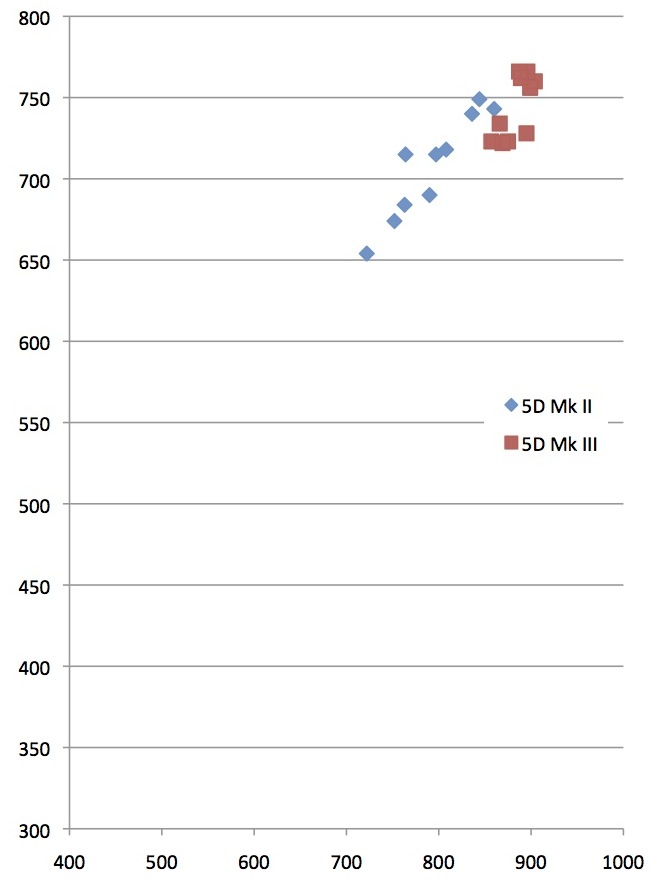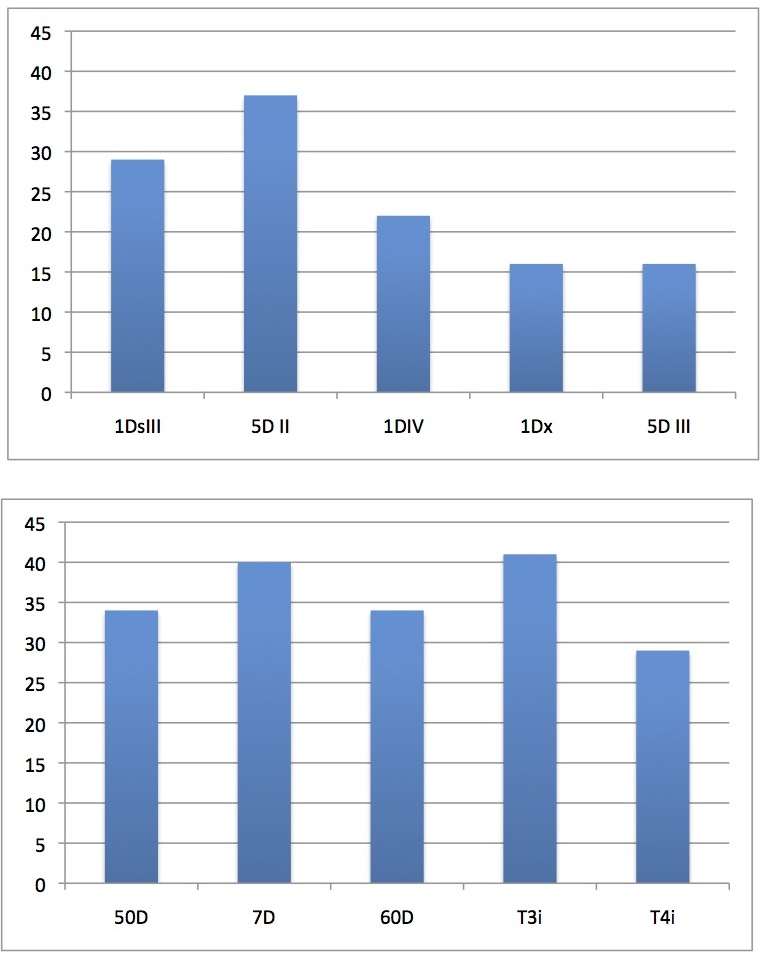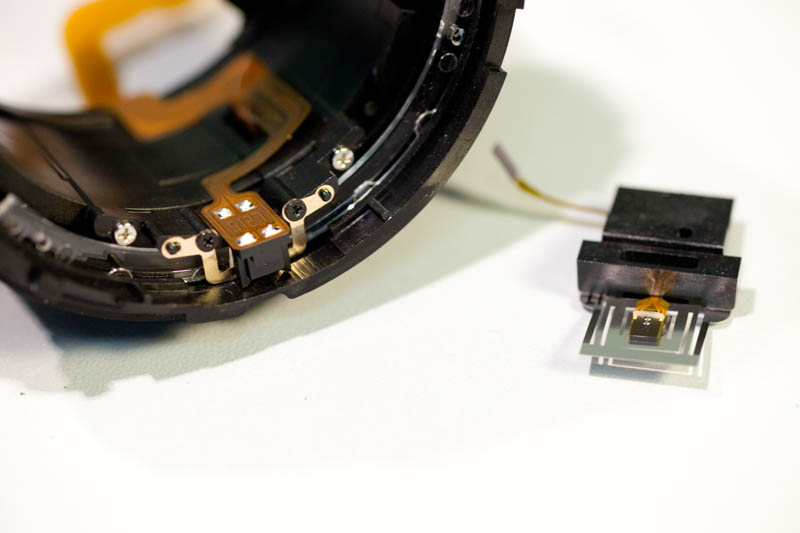Technical Discussions
Autofocus Reality Part 3B: Canon Cameras
Some days it’s good to be a geeky gear-head. This is one of them because a) I finished testing autofocus on all of the Canon camera bodies we had, b) I actually found out some interesting stuff, and c) I got worked up about camera marketers while doing it, so I have my next post in the works already.
Because I’ve been writing this series on the fly (telling you what we found as we found it), I’ll keep going in that fashion and keep the conclusions for the end of the article.

What We’ve Found So Far
In the first Autofocus Reality article, we demonstrated two things:
1. Phase-detection autofocus (even using still targets and center-point only) wasn’t nearly as accurate as contrast detection.
2. The contrast-detection autofocus was about as accurate as the most careful manual focusing.
Part two of the series showed that a few newer lenses did focus as accurately as contrast detection on 5D Mark III cameras but not on 5D Mark II cameras. The third article (part 3A) showed that the newest Canon lenses (40mm f/2.8, 24mm f/2.8 IS, 28mm f/2.8 IS, 70-300mm L IS and 300mm f/2.8 IS II) focus more accurately when mounted to 5D Mark III camera but not on 5D Mark II cameras.
The Canon 70-200 f2.8 IS II, oddly enough, seemed not quite as good as the above lenses, but more accurate than the older ones. Whether this was oddness in my measurements or a real finding, I wasn’t sure.
Since we knew that the newest lenses autofocused accurately on 5DIII but not on 5DII cameras, the next step was obviously to compare an accurate AF lens on different camera bodies to see with which ones it was capable of accuracy.
We expected the 1Dx (which has the same AF system as the 5DIII) would be accurate. We weren’t sure about the others.
Today’s Contestants on The Focus is Right!
We know the Canon 28mm f/2.8 IS II had accurate autofocus on the Canon 5DIII so we chose one copy to be our test lens.
We AF microadjusted each camera to the lens prior to shooting. If the camera did not offer AF microadjustment, we checked the body with the test lens and exchanged it for another copy if the lens back or frontfocused at the test distance.
(Microfocus adjustment makes absolutely no difference in the shot-to-shot variation in AF–it only improves the average value of the group. But I got tired of explaining that to people in the previous articles. It was easier to just do it than to answer another 50 emails.)
We then tested it in our Imatest lab using one copy of each Canon camera we carry. To save you from running amok on the internet, finding out which cameras are how old and have what kind of autofocus, I’ve listed that information in the table below.
| Camera | Year released | Year firmware | AF description | ||||||||
| 1DsIII | Dec-07 | 12/16/09 | 45 point, 19 cross, 26 assist, f/4 at center, dedicated AF processor | ||||||||
| 5D II | Dec-08 | 2/28/12 | 9 point, f/2.8 cross center | ||||||||
| 50D | Dec-08 | 2/28/12 | 9 point cross, dual diagonal center cross | ||||||||
| 7D | Aug-09 | 4/25/11 | 19 point, all cross, center dual diagonal cross (advanced algorithm), first “zone AF” and “spot AF” | ||||||||
| 1DIV | Dec-09 | 3/29/12 | 45 point, 39 cross (f/2.8-f/5.6, f4 at center), first AF expansion camera | ||||||||
| 60D | Aug-10 | 6/19/12 | 9 point, f/2.8 cross center | ||||||||
| T3i | Jan-11 | 1/30/12 | 9 point, f/2.8 cross center | ||||||||
| 1Dx | Mar-12 | 2012 | 61 point reticular, 41 cross type, 5 dual diagonal cross, including center | ||||||||
| 5D III | Mar-12 | 2012 | 61 point reticular, 41 cross type, 5 dual diagonal cross, including center | ||||||||
| T4i | Apr-12 | 2012 | 9 point, f/2.8 dual cross center, hybrid CMOS AF Live View | ||||||||
I suspected that the autofocus improvement we’ve seen had more to do with hardware than firmware, but I listed both year of release and year of latest firmware upgrade for completeness. I also listed the basics of the camera’s AF system, as well as any marketing comments made about it at release like the 7D having “the most advanced AF algorithms.”
My thought going in was the difference would be in hardware not firmware. I don’t think any amount of firmware is going to make the AF sensor on the lower left behave like the one on the lower right, even in center-point, single-shot mode.

The Results
In the lens variation article, we used the standard deviation (SD) to measure how accurately the camera focused: Softer focus results in lower Imatest values. As an example, we’ve put up a graph of Imatest values for the 5D Mk II versus the 5D Mk III below.

As you can see, the 5D Mk III shots (red square) are all very similar. The 5D Mk II shots (blue diamonds) are more spread out: The variation in shot-to-shot focus is greater.
In this example, the SD of the 5D Mk III samples was 17 lp/ih, while the SD of the 5D Mk II was 38.5. Those are similar to the numbers we’ve seen over and over—accurate focusing combinations have SDs in the teens while less accurate ones have SDs in the 30s.
Rather than clog up the post with a lot more graphs, I’ll list the SDs of the various cameras with the 28mm f/2.8 IS lens in the table below.
| Camera | SD |
| 1DsIII | 29 |
| 5D II | 38.5 |
| 50D | 34 |
| 7D | 41 |
| 1DIV | 22 |
| 60D | 34 |
| T3i | 41 |
| 1Dx | 17 |
| 5D III | 17 |
| T4i | 29 |
It’s a little confusing. There’s a range of variation, of course. But clearly the 5DIII and 1Dx do better than the other cameras, while the 1D Mk IV seems to be a bit between those two and the rest of the pack.
It seems a little clearer to me if we graph the standard deviations and separate the cameras by type (more expensive at the top, less expensive at the bottom.) The oldest cameras in both groups are on the left, while the newest are on the right.

A couple of points are worth making.
The graph of the more expensive cameras seems to show a pretty logical progression. The 1Ds III is by far the oldest, having been around since 2007. But it included every possible AF technology of the day, including a separate AF processing chip. The 5D Mk II, even on its release, was known to have “consumer-grade” autofocus.
Despite my well-recognized modesty, I will also point out that when the 5D Mk III was first released, and Canon fanboys were dropping off cliffs right and left, I said “the 5D III is no minor-upgrade camera; it’s an entirely new camera using the old camera’s name”. Its autofocus system is certainly not a minor upgrade–it’s moved over to the big-boy camera side.
I had hoped the T4i might be more accurate than it was, at least with new lenses. It does seem more accurate than the other consumer / prosumer cameras in phase detection, but it’s not nearly as good as the 1Dx or 5D III.
I assume that it’s new hybrid LiveView system does not carry over to create phase-detection AF. I will say, in it’s defense, that when focusing in LiveView it is obviously faster than and just as accurate as any of the other cameras, including the 5DIII and 1Dx.
So Why Could This Be?
All this autofocus stuff 1) gave me a headache and 2) made me rather curious and uncertain.
I started doing a simple demonstration of what I already knew: Phase-detection AF isn’t as accurate as contrast-detection AF. But then I got results that indicated sometimes it is just as accurate as LiveView. But you have to have a certain camera and a certain lens or it doesn’t happen.
This didn’t make much sense to me.
I would have understood if each generation of newer cameras and lenses got a little better. Or if a new camera or lens was dramatically better. But why a rather sudden change, and why did you need both a new camera and a new lens?
I spent a fair amount of time emailing with Dave Etchells of The Imaging Resource and SLRGear.com who was kind enough to bounce ideas back and forth with me. His thoughts sent me on the right track for figuring this out.
I started off by trying to find out how long it took for an autofocus improvement to go from idea to released-to-the-public. I found one answer in a Canon patent from 2003 describing combined phase / contrast-detection AF in the camera mated to a lens using a stepper motor.
Which we saw . . . oh, yeah. Now. With the Canon T4i / EOS-M sensors and new STM motored lenses.
One thing of interest in this patent application, tucked away in the background section, is the following statement:
. . . though the prior art indicates a method for realizing high speed and high precision of autofocusing at the same time, it does not accompany a lens drive control for realizing this and thus does not adequately realize [. . .] high precision of autofocusing.
In other words, back in 2003, Canon recognized that a high-accuracy AF system in the camera required a more accurate lens drive to yield precise autofocus. You can’t have one without the other.
Suddenly the need for both a new camera and a new lens to get accurate autofocus began to make sense. But wait, the patent was talking about using a stepper motor to achieve accurate AF. We did find the 40mm pancake (stepper motor) was more accurate. But we also found that the new 24mm, 28mm f/2.8 IS and 300mm f/2.8 IS II lenses were more accurate. Yet they don’t have stepper motors.
Then I read on a bit further in the patent:
In order to achieve this objective, this invention provides a camera system comprising: a first focus detection unit, a second focus detection unit, a stepping motor that drives a focusing lens, . . . or a rotation detector, which detects the rotation . . . of the motor. . . The control circuit performs closed-loop control, based on the output of the rotation detector to control the motor.
The wording of this patent, back in 2003, suggests that closed-loop was not how AF worked at that time. It was largely open loop. The camera took a measurement and told the lens where it should go. Done.
This is backed up by a lot of other information, including statements in Canon’s “EF Lens Work III” and quotes made by a lot of people who would have known.
It’s clear that later AF systems were closed loop (the camera double checked where the lens had gone), although exactly when and where that change occurred I don’t know. But this probably explains the lengthy, and now largely meaningless, debates about whether systems were open or closed-loop: They used to be open. Now some (probably most) are closed.
More to the point, though, is the comment that a rotation detector would be needed in lenses driven by ultrasonic motors to increase accuracy of the focusing movement.
If this is the case, then the newer Canon lenses should definitely have a rotation detector built into them. We know there are rotation detectors in many lenses released after 2000, but if they are in older lenses we can’t identify them, so this fits too. (As an aside, I am particularly skilled in finding them because usually if you touch them with your fingers the lens won’t focus anymore and the unit has to be replaced.)

From Left: A Canon and Nikon magnetic rotation detector.
Just to be certain, I asked Aaron to find an excuse to take apart one of the new lenses. Or failing that, I told Aaron to take one apart and not tell Tyler or Drew, who never really believe we can put them back together correctly.
The result: Aaron checked and the newer lenses did have rotation detectors.
There was one other big hint hiding in plain sight in Canon’s resource article on precision cross-type AF sensors. The article states that the farther apart each pair of AF sensors are (each pair compares phase from opposite sides of the lens) the more accurate the sensor. It also states only the 5D Mk III and 1Dx have them. I italicized some of the quote for emphasis:
[…]simply by reading which pixels on each sensor line are being struck by light, the AF system can tell instantly what direction to move the lens in for proper focus, and by how much to move it. . . Canon EOS SLRs with high-precision AF sensors simply move the pairs of sensors much farther apart, and accordingly, the AF information can be more finely broken-down and reacted to.
The 5DIII and 1DX have f/5.6 cross-type sensors (most previous cross-type required f/2.8 or faster lenses). The central AF sensors in these cameras also have diagonal cross sensors. The article continues:
For pros who prefer to use the center AF point, simply manually selecting it [. . . ] gives the user the highest precision AF possible with these cameras (assuming an f/2.8 or faster lens is being used). And, with their unique diagonal cross-type layout, the AF points are much more likely to latch-on to typical horizontal or vertical subject details.
In Summary
As it turns out, my little tests just confirm things that were already published (if obscurely.)
The two newest Canon cameras have more accurate phase-detection sensors than their previous cameras. The newest lenses have more accurate focus movement (or provide more accurate focus movement feedback, or both) that takes advantage of those sensors.
Older cameras don’t have accurate enough AF sensors to take advantage of the new lenses’ capabilities. Older lenses can’t move their focusing elements with enough accuracy to take advantage of the new cameras’ accurate sensors.
It’s rather sad (given the amount of other work that’s piled up during this little series) that I didn’t find this information until after I’d done all this testing, but it’s rather a testament to our times. There’s so much marketing drivel and useless verbiage thrown about that the marketing noise drowns out the actual useful information the camera makers offer us.
But that’s the topic of another blog post in which I will take personal offense at the marketing crap that’s been shoveled our way at an ever-increasing rate.
I don’t believe we photographers are nearly as stupid as the marketers seem to think we are. In the meantime, while I’m on this rant, I highly recommend Thom Hogan’s very funny look at camera icons “A Different Kind of Focus.” Thom writes better stuff sitting on the tarmac waiting for takeoff than I do at my desk.
And I guess, given all the marketing fluff, I wouldn’t have really believed “better autofocus” if I hadn’t seen it with my own tests.
I’ve heard it before and it wasn’t so. Not to mention I doubt seriously we’d have seen the marketers say, “better autofocus…but not with the lenses you already have.” So maybe this is worthwhile after all.
Otherwise I might have put my trusty old 85mm f/1.8 on a 5D III and thought “not better at all, they’re lying to me again.”
Roger Cicala (with thanks to Aaron Closz and Dave Etchells)
Lensrentals.com
August 2012
Author: Roger Cicala
I’m Roger and I am the founder of Lensrentals.com. Hailed as one of the optic nerds here, I enjoy shooting collimated light through 30X microscope objectives in my spare time. When I do take real pictures I like using something different: a Medium format, or Pentax K1, or a Sony RX1R.
-
Tom
-
CheshireCat
-
Wilba
-
Charles Wright (’77-79, ’91-92)
-
discuss21
-
Helmut
-
Helmut
-
Volker Borchard
-
Derek
-
Phil
-
Lynn Allan
-
Igor
-
Anders
-
Peter L
-
Daniel Low
-
JB
-
Wilba
-
Tony Webster
-
John Bickford
-
Alex
-
CyberDyneSystems
-
TTMartin
-
Bill
-
Dave Sucsy
